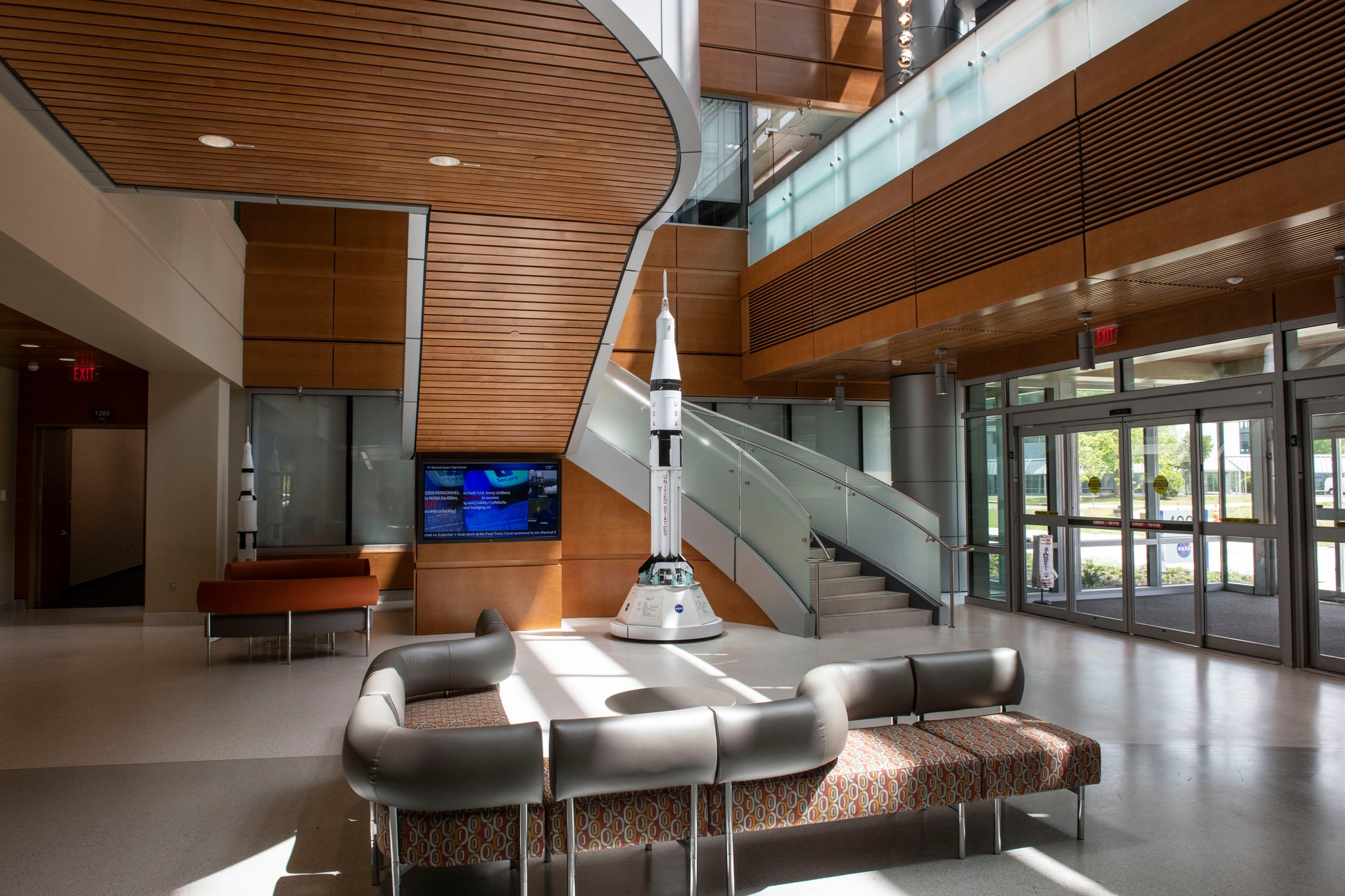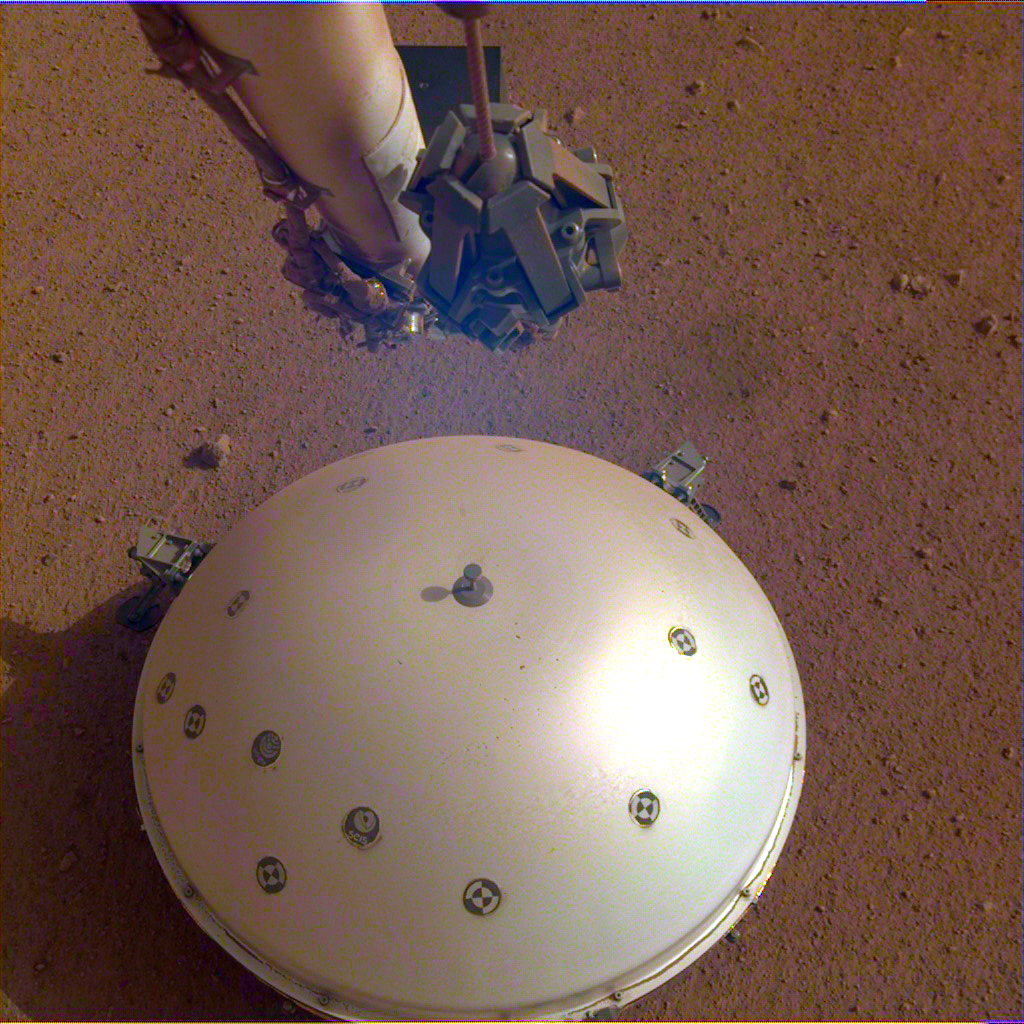In This Week’s Star
- Cygnus Resupply Vehicle Launches and Arrives at International Space Station
- Marshall Opens Building 4221, Its Newest ‘Green’ Building
- NASA Day in Montgomery Highlights Alabama’s Role in Returning to the Moon
- NASA’s InSight Lander Captures First Martian Tremors
- Marshall Hosts NASA Payload Operations & Integration Working Group Meeting
- Pass the Torch Event Celebrates Marshall Women, Past and Present
- This Week in NASA History: Mississippi Test Facility Captive-Fires S-II-T – April 23, 1966
Cygnus Resupply Vehicle Launches and Arrives at International Space Station
Northrop Grumman’s Cygnus spacecraft launched to the International Space Station on April 17 from NASA’s Wallops Flight Facility and docked to the orbiting outpost April 19 with about 7,600 pounds of science investigations and cargo.
On April 19, Expedition 59 astronauts Anne McClain of NASA and David Saint-Jacques of the Canadian Space Agency used the space station’s robotic arm to capture Cygnus, while NASA’s Nick Hague monitored telemetry. The spacecraft will stay at the space station until July.
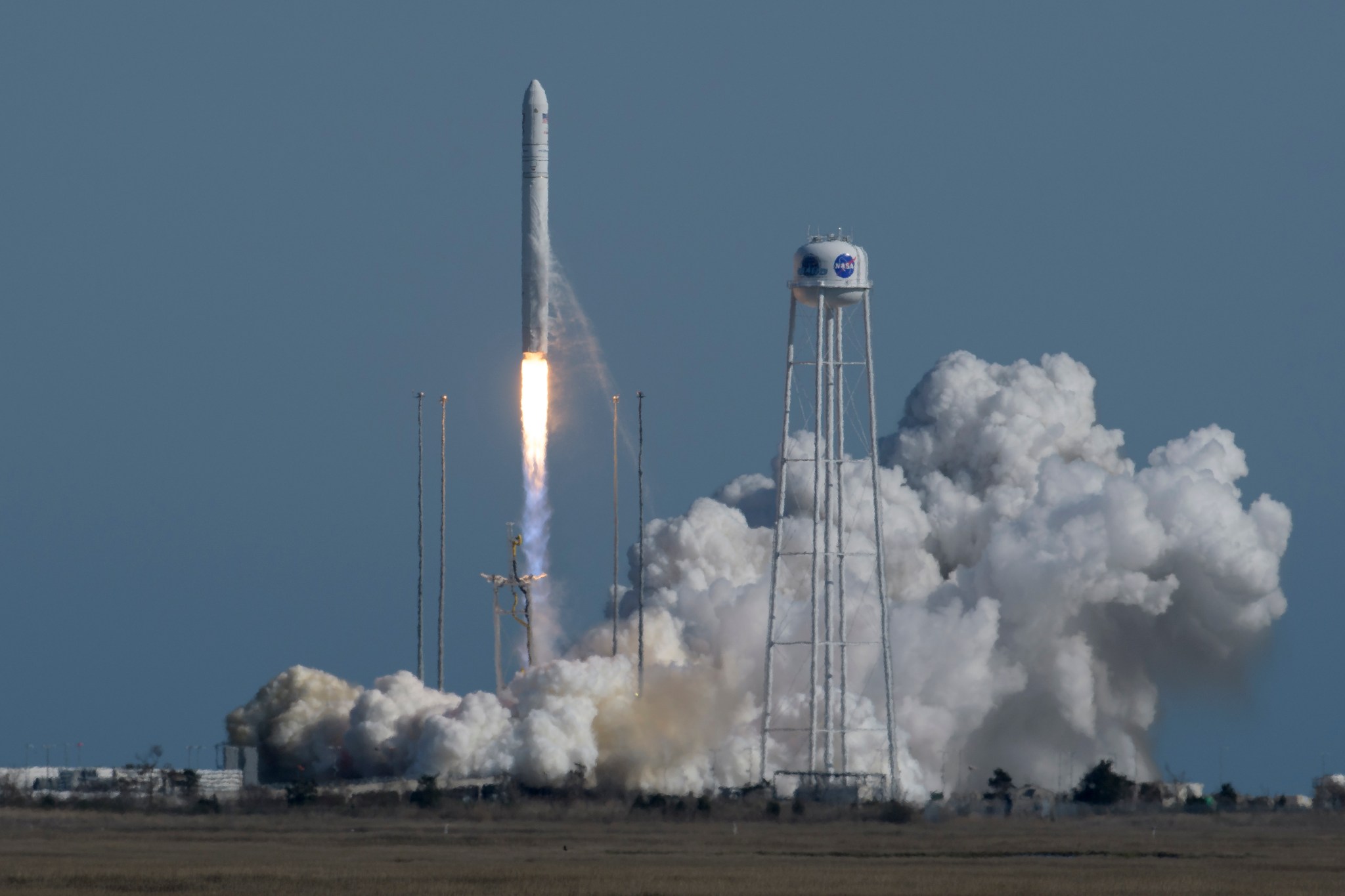
The delivery – Northrop Grumman’s 11th cargo flight to the space station under NASA’s Commercial Resupply Services contract – will support dozens of new and existing investigations. Here are details about some of the scientific investigations Cygnus is delivering to the space station:
Models for growing increasingly complex materials
Advanced Colloids Experiment-Temperature-10, or ACE-T-10, will test gels in a microgravity environment. This research could aid in the development of increasingly complex materials that may serve as the building blocks for a range of applications on Earth including foods, drugs and electronic devices. The process also may provide an efficient method to build new materials and equipment in space.
Better life science research in a few drops
Although the space station is well equipped for health and life sciences research, the equipment available for cellular and molecular biology still is limited compared to capabilities found in laboratories on Earth. To address this limitation, CSA designed Bio-Analyzer, a new tool the size of a video game console that astronauts on station easily can use to test body fluids such as blood, saliva and urine, with just a few drops. It returns key analyses — such as blood cell counts – in just two to three hours, eliminating the need to freeze and store samples.
Analyzing aging of the arteries in astronauts
The Vascular Aging investigation uses ultrasounds, blood samples, oral glucose tolerance tests and wearable sensors to study aging-like changes that occur in many astronauts during their stay on the space station. It’s one of three Canadian experiments exploring the effects of weightlessness on the blood vessels and heart, and the links between these effects and bone health, blood biomarkers, insulin resistance and radiation exposure. Increased understanding of these mechanisms can be used to address vascular aging in both astronauts and the aging Earth population.
Testing immune response in space
Spaceflight is known to have a dramatic influence on an astronaut’s immune response, but there is little research on its effect following an actual challenge to the body’s immune system. The rodent immune system closely parallels that of humans, and Rodent Research-12: Tetanus Antibody Response by B cells in Space, or TARBIS, will examine the effects of spaceflight on the function of antibody production and immune memory. This investigation aims to advance the development of measures to counter these effects and help maintain crew health during future long-duration space missions. On Earth, it could advance research to improve the effectiveness of vaccines and therapies for treating diseases and cancers.
Big buzz for new robot
A fleet of small robots is set to take on big jobs aboard the space station. Building on the success of SPHERES, NASA will test Astrobee, a robotic system comprised of three cube-shaped robots and a docking station for recharging; the first two are aboard Cygnus. The free-flying robots use electric fans for propulsion and cameras and sensors help them navigate their surroundings. The robots also have an arm to grasp station handrails or grab and hold items. Astrobee can operate in automated mode or under remote control from the ground as it assists with routine chores on station, and it requires no supervision from the crew. This has the potential to free up astronauts to conduct more research.
These are just a few of the hundreds of investigations that will help NASA and the spaceflight industry learn how to keep astronauts healthy during long-duration space travel and demonstrate technologies for future human and robotic exploration beyond low-Earth orbit to the Moon and Mars. Space station research also provides opportunities for other U.S. government agencies, private industry and academic and research institutions to conduct microgravity research that leads to new technologies, medical treatments and products that improve life on Earth.
The Payload Operations Integrations Center at NASA’s Marshall Space Flight Center coordinates all U.S., European, Japanese and Canadian scientific and commercial experiments on the station, synchronizes payload activities of international partners and directs communications between ISS crewmembers and researchers around the world with onboard experiments.
Keep up with the International Space Station, and its research and crews here.
Marshall Opens Building 4221, Its Newest ‘Green’ Building
By Rick Smith
NASA’s Marshall Space Flight Center officially opened the doors of its newest environmentally friendly building on Earth Day, April 22, with a ribbon-cutting ceremony that included U.S. Sen. Doug Jones of Alabama, representatives of NASA Headquarters and the U.S. Army Corps of Engineers.
Building 4221, situated on the north side of the 4200 Marshall office complex, is a glass-and-steel structure designed to rigorous federal guidelines on energy and water efficiency. The five-story building provides offices and workspace for some 440 team members supporting Marshall’s Human Exploration Development & Operations Office, its Science & Technology Office and the NASA Engineering & Safety Center – all critically involved in the agency’s mission to once more put boots on the Moon and prepare for human exploration of Mars.
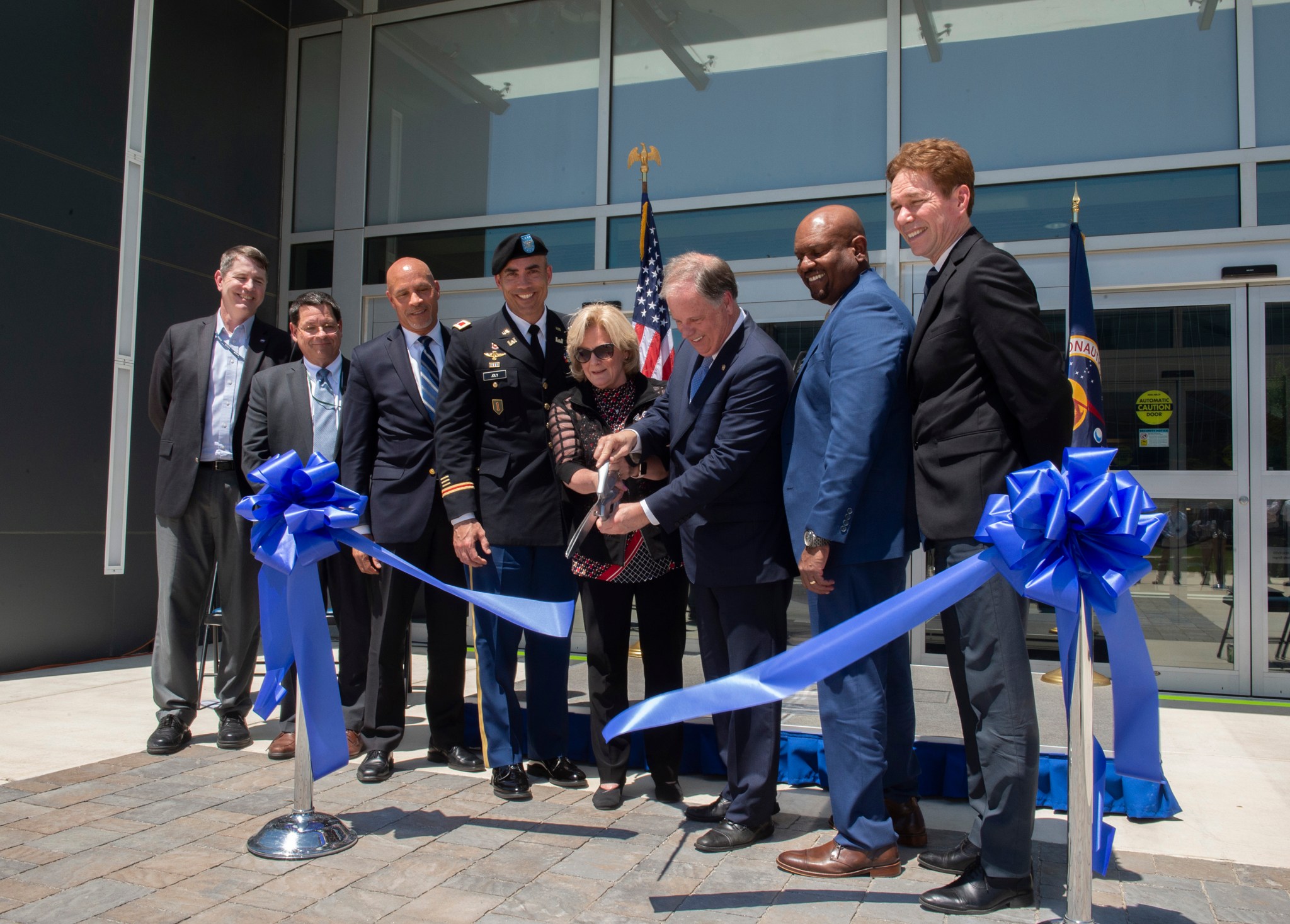
“The completion of Building 4221 marks a significant milestone,” Marshall Director Jody Singer told workers and officials during the grand opening event. “We’re adding effective, environmentally friendly and pocketbook friendly infrastructure for the next two generations – and demonstrating NASA’s continuing commitment to good stewardship of taxpayer dollars.”
Singer’s address was bookended by remarks from Col. Sebastien Joly, commander of the U.S. Army Corps of Engineers’ Mobile District, and Jones. Both praised the Marshall team for its work to support NASA’s mission and noted the significant environmental value of Building 4221.
The entire structure is specially insulated, with much of the exterior covered in low-emissivity glass that deflects heat, reducing cooling costs. Rooftop solar-power units absorb energy to augment electrical power, and 99% of the building’s lighting features cost-efficient LEDs, or light-emitting diodes.
Building 4221 is being certified by the U.S. Green Building Council for Leadership in Energy and Environmental Design, the national standard for development of high-performance, sustainable structures. The new structure will be the ninth LEED-certified facility at Marshall, which also is home to NASA’s first LEED certified structure: Building 4600, the anchor of Marshall’s high-tech engineering complex, which opened in 2006.
Marshall’s refurbishment of the 4200 complex began with the opening of Building 4220 in 2014. Both 4220 and 4221 are part of NASA’s repair-by-replacement plan – tearing down costly, aging structures and replacing them with new facilities offering measurable health, safety and cost benefits. The end goal is to dramatically cut infrastructure operating costs and to reduce Marshall’s overall square footage on Redstone Arsenal, its home since July 1960, by more than 25%.
The new building is expected to slash utility costs by more than 32% over the vintage Building 4201, situated south of Building 4221 across the quad complex, and will save more than 16% of the total operational costs of its predecessor. Building 4201 is next up for demolition in Marshall’s Facilities Master Plan, which will connect its state-of-the-art facilities via an interconnected, campus-style greenway of walking paths.
Building 4221 was designed by the Nashville-based architectural firm of Thomas Miller & Partners. Yates Construction of Philadelphia, Mississippi, constructed the facility. The Army Corps of Engineers oversaw the contract process, and NASA provided construction management and inspection services.
Smith, an ASRC Federal/Analytical Services employee, supports the Office of Strategic Analysis & Communications.
NASA Day in Montgomery Highlights Alabama’s Role in Returning to the Moon
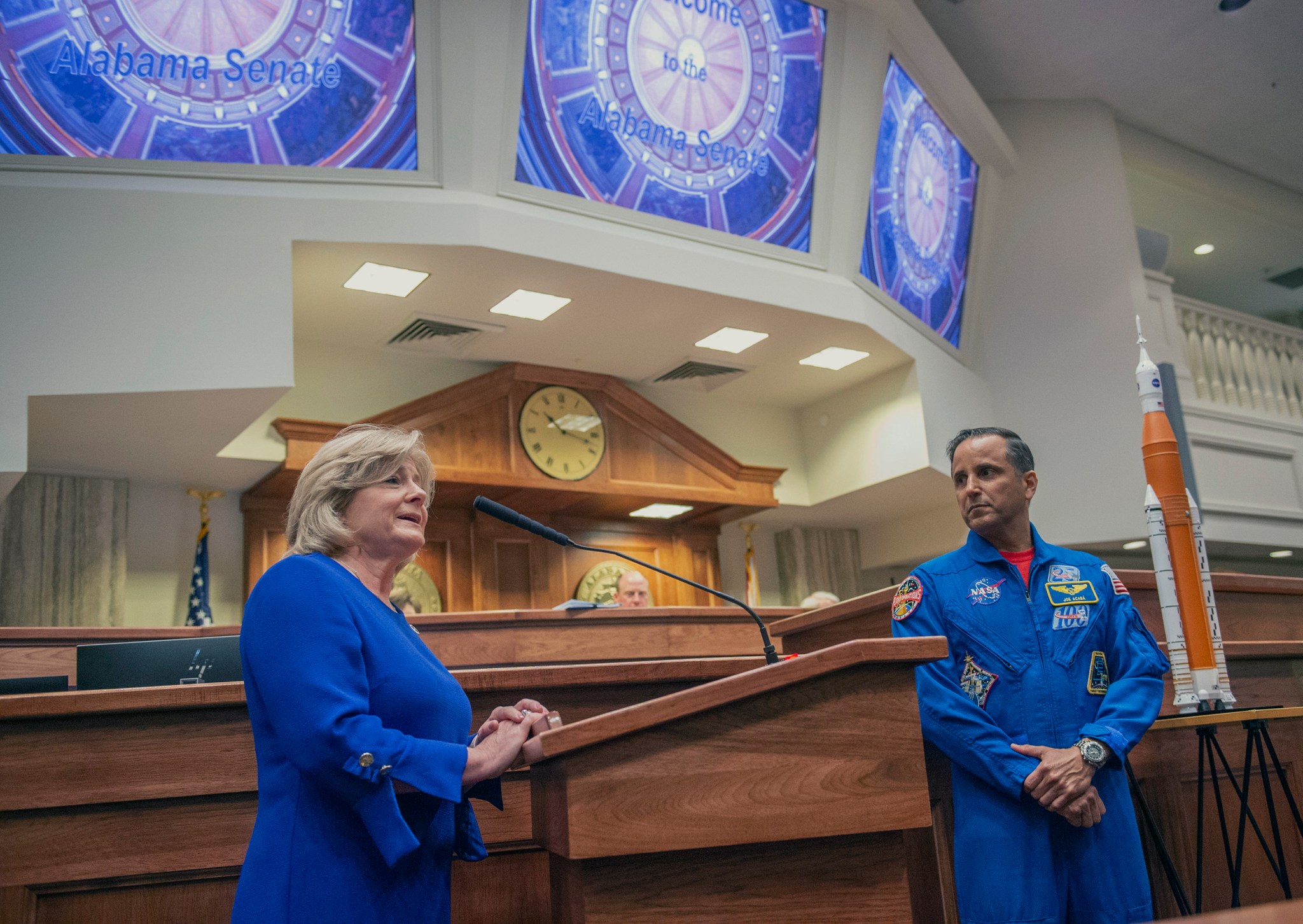
NASA Marshall Space Flight Center Director Jody Singer, left, and astronaut Joe Acaba address the Alabama State Senate at NASA Day in Montgomery April 18, at the State House. Singer, Acaba and members of the Marshall leadership team highlighted Alabama’s role in leading America back to the Moon and shared the importance of recruiting the next generation of explorers to study the fields of science, technology, engineering and mathematics. NASA Day in Montgomery, held annually, recognizes the space agency’s partnership with the State of Alabama. (NASA/Emmett Given)
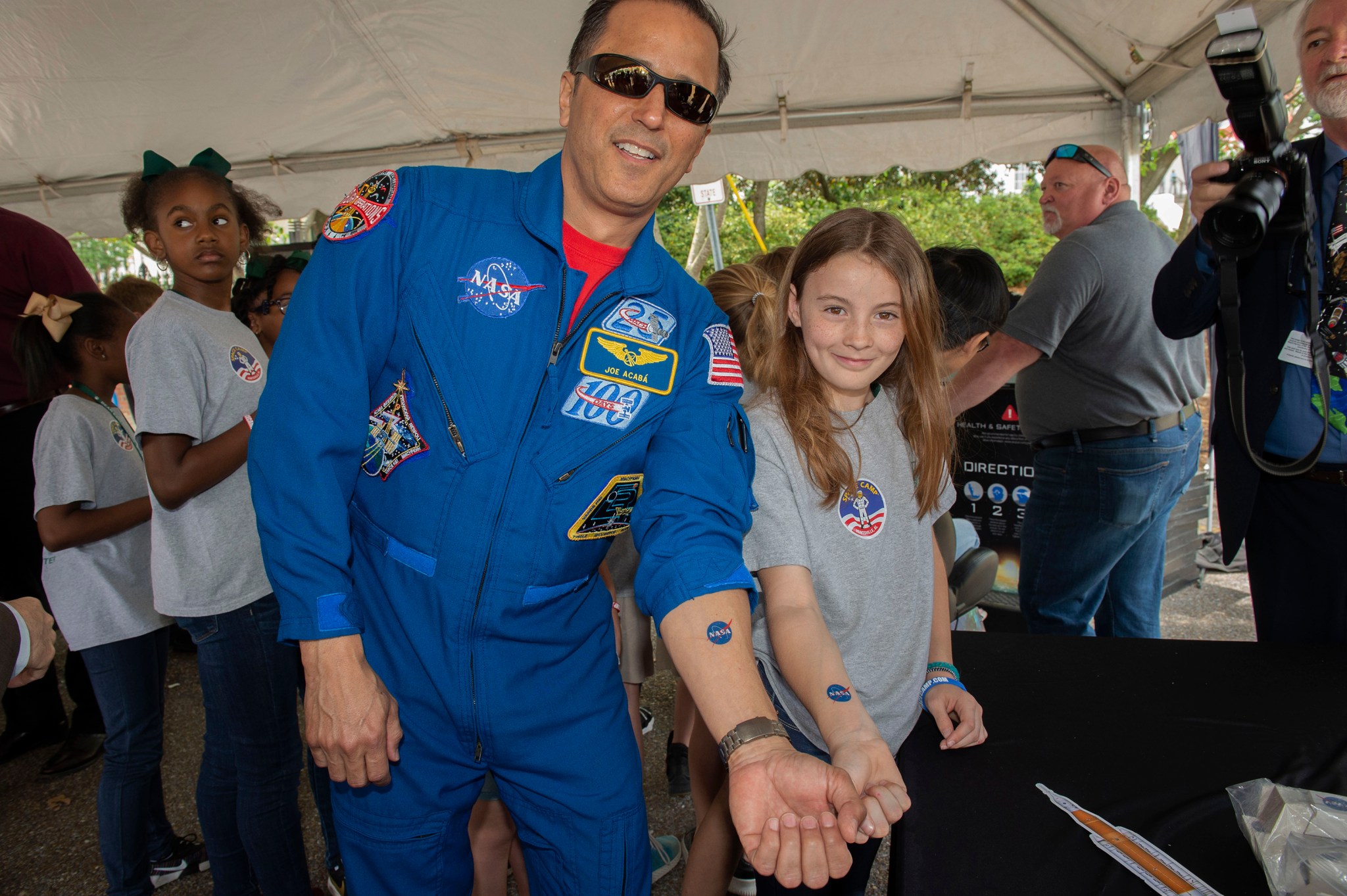
NASA astronaut Joe Acaba, left, and a student from Montgomery’s Bear Exploration Center for Mathematics, Science and Technology, show off their NASA “tattoos” on the lawn of the Alabama State Capitol. Acaba, along with Marshall leadership, visited with hundreds of students on the lawn of the capitol and fifth and sixth graders at Pike Road Middle School as a part of NASA Day in Montgomery. (NASA/Emmett Given)
NASA’s InSight Lander Captures First Martian Tremors
NASA’s Mars InSight lander has measured and recorded for the first time a likely “marsquake.” The signal was detected by InSight’s seismometer, which the lander placed on the Martian surface Dec. 19, 2018. InSight is part of NASA’s Discovery Program, managed by Marshall Space Flight Center.
The faint seismic signal was recorded on April 6, the lander’s 128th Martian day, or sol. This is the first recorded trembling that appears to have come from inside the planet, as opposed to being caused by forces above the surface, such as wind. Scientists still are examining the data to determine the exact cause of the signal.
“Part of the fun of the InSight mission is seeing what Mars seismicity is really like – more like Earth, or more like the Moon?” said Renee Weber, InSight co-investigator and chief of the Heliophysics and Planetary Science branch at Marshall. “Until now, we could only theorize, and that answer could still change as more and more events are detected.”
The new seismic event was too small to provide solid data on the Martian interior, which is one of InSight’s main objectives. The Martian surface is extremely quiet, allowing the lander’s Seismic Experiment for Interior Structure (SEIS) instrument, InSight’s specially designed seismometer, to pick up faint rumbles. In contrast, Earth’s surface is quivering constantly from seismic noise created by oceans and weather. An event of this size in Southern California would be lost among dozens of tiny crackles that occur every day.
NASA’s Apollo astronauts installed five seismometers that measured thousands of quakes while operating on the Moon between 1969 and 1977. Different materials can change the speed of seismic waves or reflect them, allowing scientists to learn about the interior of the Moon and model its formation.
InSight’s seismometer will enable scientists to gather similar data about Mars. By studying Mars’s deep interior, they hope to learn how other rocky worlds, including Earth and the Moon, formed.
“Although the Apollo data from the Moon are now 50 years old, they still provide new information as we find new methods of analysis to apply,” said Weber. “Just think what we might learn from InSight’s Mars data 50 years in the future.”
Three other signals that may be of seismic origin occurred on March 14 (Sol 105), April 10 (Sol 132) and April 11 (Sol 133). These enigmatic signals are far more ambiguous to the InSight team, but do not appear to be clearly associated with atmospheric disturbances or known noise sources. They are even smaller than the Sol 128 event, and were only detected by SEIS’ more sensitive Very Broad Band sensors. The team will continue to study these events to try to determine their origin.
Regardless of its cause, the Sol 128 signal is an exciting milestone for the team.
“It was hard to be patient while we waited for Mars to give us a quake,” said Weber, “but it’s very exciting to finally have some seismic events to analyze.”
JPL manages InSight for NASA’s Science Mission Directorate. Lockheed Martin Space in Denver built the InSight spacecraft and supports spacecraft operations for the mission. A number of European partners support the mission.
Listen to audio of this “marsquake” here. For more information about InSight, visit here.
Marshall Hosts NASA Payload Operations & Integration Working Group Meeting
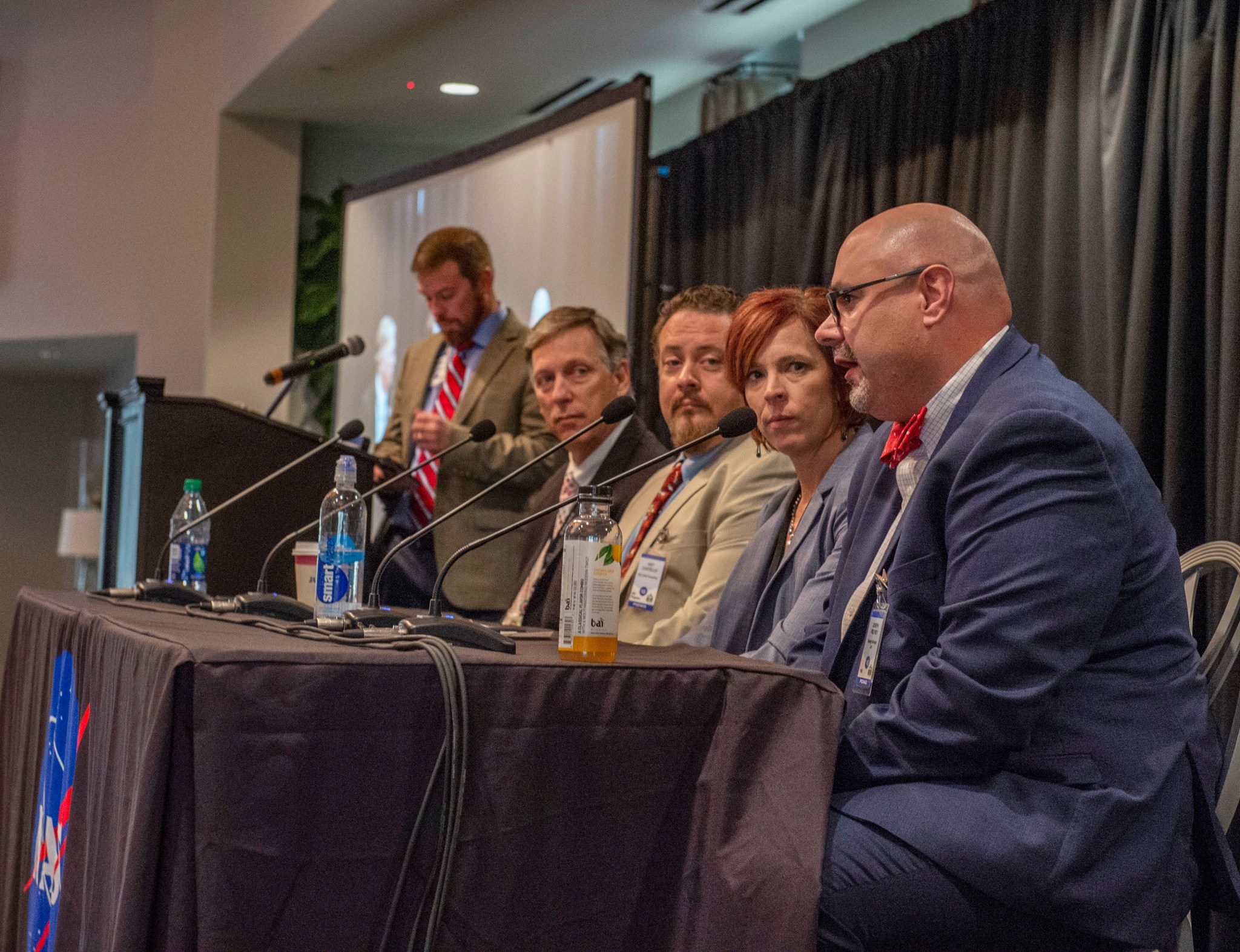
A panel of NASA experts kicked off the International Space Station Payload Operations Integration Working Group meeting on April 23. Pictured from left are moderator Beau Simpson, a payload operations director at NASA’s Marshall Space Flight Center; Kenny Todd, manager of ISS program operations integration; Kirt Costello, acting ISS chief scientist; Ryan Prouty, manager of the ISS Program Mission Integration & Operations Office; and Joseph Pelfrey, deputy manager of Marshall‘s Human Exploration Development & Operations Office and acting ISS payload operations cost account manager. The meeting, which annually draws scientists and technologists from across government, industry and academia, was held at the Huntsville Botanical Garden April 23-25. The workshop helps payload developers, science investigators and project managers coordinate work on experiments and payloads. It was organized by Marshall’s Payload Operations Team. (NASA/MSFC/Emmett Given)
Pass the Torch Event Celebrates Marshall Women, Past and Present
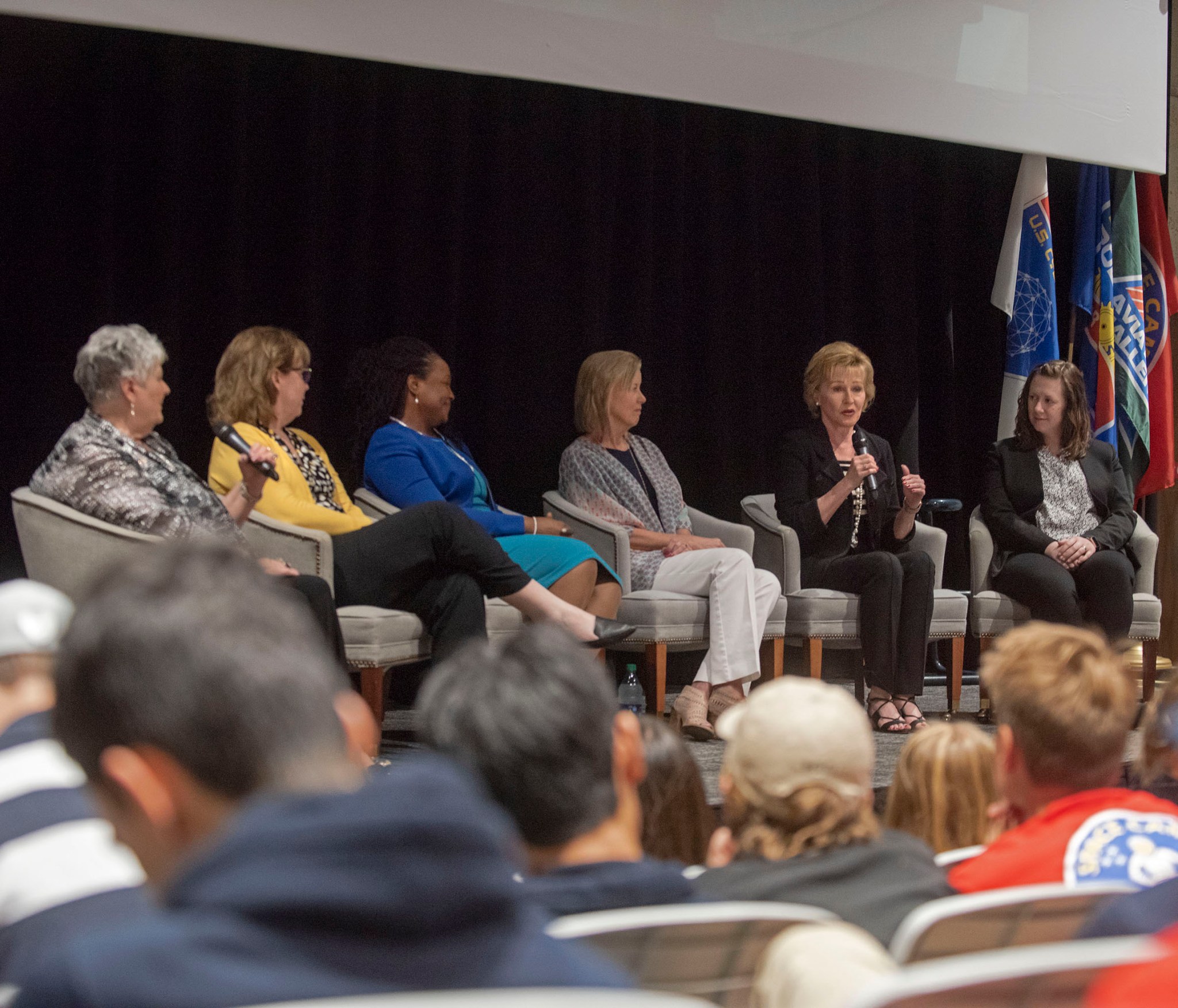
On the heels of Women’s History Month, women from NASA Marshall Space Flight Center’s past and present speak at the U.S. Space & Rocket Center’s Pass the Torch event April 18. The panel members discussed the changing role of women at Marshall, highlighting experiences and stories that demonstrate the cultural changes that have taken place from 1960 to the present. Panelists included, from the left, Bennie Jacks, Volunteer & Community Outreach coordinator at U. S. Space & Rocket Center; Mary Beth Koelbl, director of Marshall’s Propulsion Systems Department; Angelia Walker, deputy director of the Spacecraft and Vehicle Systems Department in Marshall’s Engineering Directorate; Teresa Vanhooser, former Marshall deputy director; Sandy Coleman, who retired from NASA in 2006 as manager of the Space Shuttle External Tank Project; and Lisa McCollum, project engineer in Marshall’s solid propulsion systems division. Pass the Torch is an inspirational series that features innovative, influential and interesting professionals from industry, academia and government speaking about their work in space, aeronautics, engineering, science research and other related fields. The series is open to the public and is a great way to reconnect with history. Learn more here. (NASA/Charles Beason)
This Week in NASA History: Mississippi Test Facility Captive-Fires S-II-T – April 23, 1966
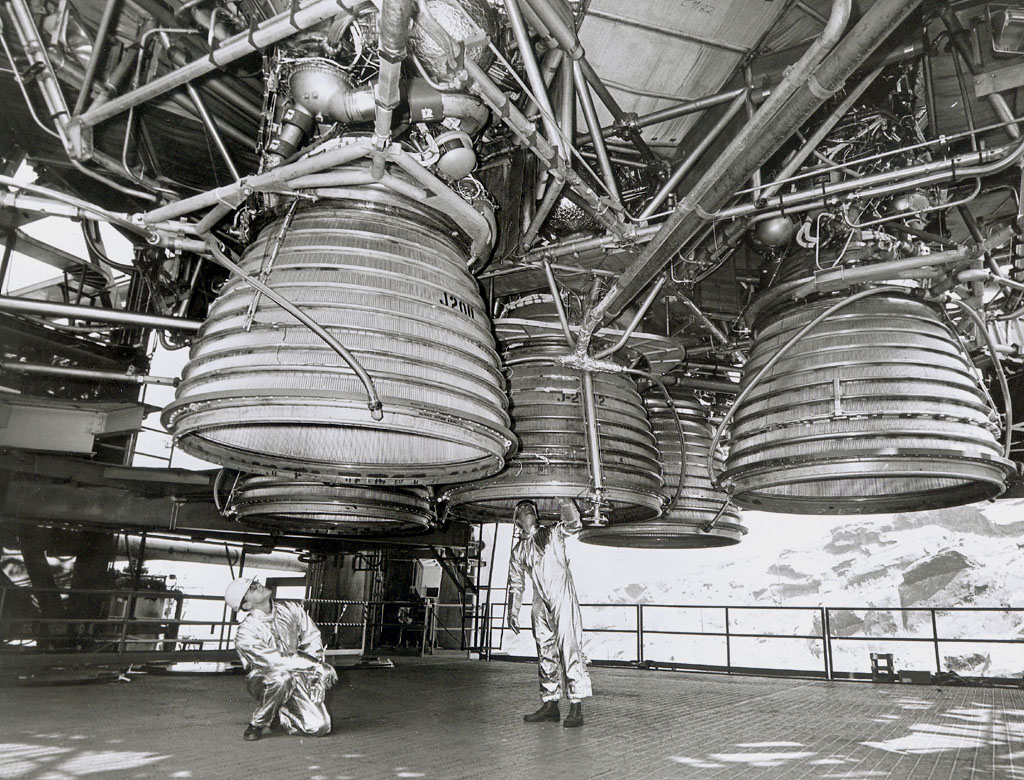
This week in 1966, the Mississippi Test Facility – today’s NASA Stennis Space Center – successfully captive-fired S-II-T, a test version of the S-II, or second stage of the Saturn V rocket, for 15 seconds. S-II-T employed five J-2 engines, each capable of producing 225,000 pounds of thrust. Here, two technicians are dwarfed by the five J-2 engines as they make final inspections prior to test firing by North American Space Division. The Saturn V rocket was designed at NASA’s Marshall Space Flight Center. Now through December 2022, NASA will mark the 50th anniversary of the Apollo Program that landed a dozen astronauts on the Moon between July 1969 and December 1972, and the first U.S. crewed mission – Apollo 8 – that circumnavigated the Moon in December 1968. The NASA History Program is responsible for generating, disseminating and preserving NASA’s remarkable history and providing a comprehensive understanding of the institutional, cultural, social, political, economic, technological and scientific aspects of NASA’s activities in aeronautics and space. For more pictures like this one and to connect to NASA’s history, visit the Marshall History Program’s webpage. (NASA)





























